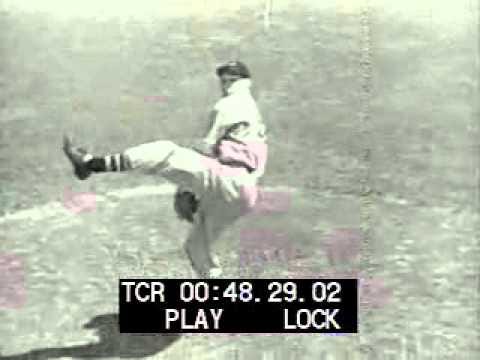One thing I’ve learned over the years is that the eye is not enough when it comes to pitching. I didn’t always believe that, to a point where I did a video breakdown series for MLB.com back in the mid-2000s. Now, there’s a middle ground where what we see is useful, but data needs to be applied to really get any sort of useable breakdown.
But let’s have some fun. Last week, I put in a video of Bob Feller’s pitching and several of you had questions about it, so let’s take a look at this in more detail.
The first thing you’ll notice is Feller’s leg kick and stride, which is measured here at five feet, six inches. Feller was listed at an even six foot, which seems reasonable. When I met Feller, I would have judged him about my height (I’m 5’10) but he was also in his late 80s at the time. This would make his stride short - less than the 80-90 percent of height rule of thumb that has been
Even in 2018, younger pitchers often have a very short stride length, according to this study. Feller’s is certainly within what would be considered a normal range. To the eyes, it’s neither overly short nor overly long, though it appears disconnected to what appears to be a very high leg kick.
This is a problem of context. Feller’s leg kick would be extremely high today, but would be considered normal at the time. The last really high leg kicks in MLB were throwbacks — Dontrelle Willis, Orlando Hernandez, even Nolan Ryan. The high leg kick vanished in the speed-80s and really never came back, replaced by heavy push in the style of Tom Seaver.
Despite the full windup and high leg kick, Feller is in a very modern position at foot strike. As his front foot hits the ground, his pitching arm is up, at “90-90” - ninety degree angles in his shoulder and elbow, his wrist in solid position as well. The follow through is pretty standard today as well.
Whether Feller actually threw 100 mph is unknown, though he does appear to have good hips, solid mechanics, and was strong enough to handle a workload. For someone his size to throw 100 is possible. Feller’s motion as shown here actually reminds me a bit of Roy Oswalt, who could get the ball there quickly.
All in all, Feller may have been an Iowa farm boy, but his mechanics hold up well in a modern context, which explains why he not only was successful but why he was able to have a long and relatively healthy career. But “120 mph?” I’m not sure, despite this video. Someone want to check the math for me?
Let’s do one more, all timer Walter Johnson. There’s not nearly as much footage of Johnson given when he played, but there is some and well …
While Feller’s motion was ‘modern’, can you imagine a scout seeing Johnson do this today? Unless Johnson did somehow actually get the ball up to 100 with this delivery, you’d never expect anything resembling success or resilience.
The problem for me isn’t the low sidearm delivery, but how he gets there. There’s almost no leg kick. The stride is extremely short, which surprises me given the talk of Johnson’s velocity. His long takeaway is one-sided, but does show good scapular control and consistency, in what little footage we have.
There’s two strange things in his delivery. First, there’s a very late but very fast pronation. In most of the footage, you can see his sleeve actually twist at release. Johnson is almost always noted for his velocity, not his movement, but this is a power sinker kind of motion. It’s not the extreme of a Chien-Ming Wang or Brandon Webb, but it does recall Roger Clemens.
It’s harder to see without the sleeve but at 0:21, you can see the motion in the upper right frame as he does a hard pronation. This protects his elbow from ‘slamming shut’ as well as puts some spin on the ball.
Back to Johnson, the one thing that really stands out for me is the rapid shoulder rotation as he delivers the ball. He has a near flat layback - his pitching forearm almost parallel to the ground as he starts to turn his humerus. (While this is shoulder rotation, we’ll note what happens at the measurement of the elbow.) There’s a very quick ‘flip’ where it goes from layback to release, almost a 180 degree arc. It’s impossible to tell just how fast this is because of inconsistent frame rates, but it looks fast.
My question about this delivery is that it looks more like a warm up pitch than it does to a batter. I can’t find great footage of Johnson in-game, but what there is shows that the delivery is much the same - a long takeaway and a low sidearm delivery - just maybe a bit more of what we’d today call ‘intent.’
Again, take these with a grain of salt. We can’t put Feller or Johnson in a motion capture lab or get Rapsodo profiles on them so this is the best we have. I’m not sure what we can really learn from them, but without other baseball, if you have a good video of someone you’d like me to break down in the future, I’ll do so. I already have one to do later this week and boy, is this one going to stir up some debate.




